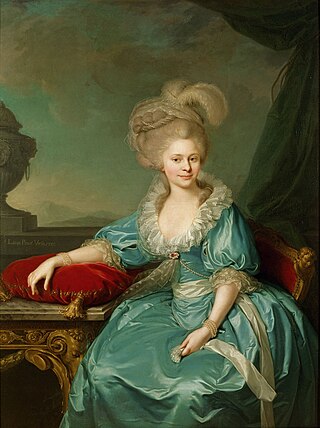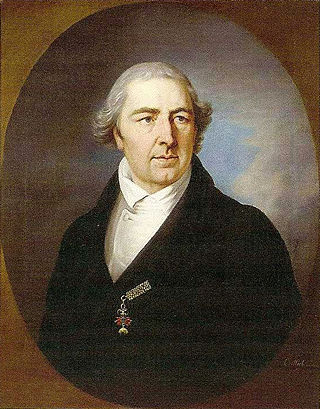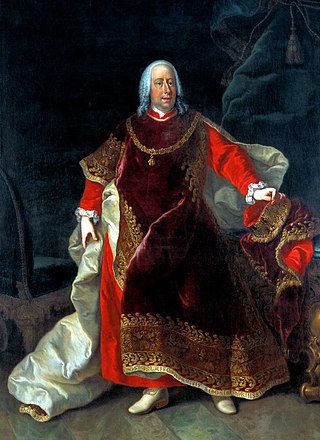
Friedrich Eugen, Duke of Württemberg was the fourth son of Karl Alexander, Duke of Württemberg, and Princess Maria Augusta of Thurn and Taxis. He was born in Stuttgart. From 1795 until 1797 he was Duke of Württemberg.

Ludwig Eugen, Duke of Württemberg, was the reigning Duke of Württemberg from 1793 until his death in 1795.

Charles Eugene was the Duke of Württemberg, and the eldest son, and successor, of Charles Alexander; his mother was Princess Marie Auguste of Thurn and Taxis.

Charles Alexander of Württemberg was a Württemberg Duke from 1698 who governed the Kingdom of Serbia as regent from 1720 until 1733, when he assumed the position of Duke of Württemberg, which he held until his death.

Elisabeth of Württemberg was a duchess of Württemberg by birth and an archduchess of Austria by her marriage to Archduke Francis of Austria.

Princess Sophia Dorothea of Prussia was the ninth child and fifth daughter of Frederick William I of Prussia and Sophia Dorothea of Hanover. By marriage, she was a Margravine of Brandenburg-Schwedt.

Brandenburg-Schwedt was a secundogeniture of the Hohenzollern margraves of Brandenburg, established by Prince Philip William who took his residence at Schwedt Castle in 1689. By appanage, they administered the manors of Schwedt and Vierraden on the Oder river as well as Wildenbruch in Pomerania. Though prosperous, the cadet branch never obtained Imperial immediacy.

Frederick (Friedrich) Margrave of Brandenburg-Bayreuth, was a member of the House of Hohenzollern and Margrave of Brandenburg-Bayreuth.

Princess Elisabeth Friederike Sophie of Brandenburg-Bayreuth, was a German princess of the House of Hohenzollern and the Duchess of Württemberg by marriage.

Friederike of Brandenburg-Schwedt was Duchess of Württemberg by marriage to Frederick II Eugene, Duke of Württemberg. She is an ancestor to many European royals of the 19th and 20th century.

Karl Alexander, 5th Prince of Thurn and Taxis, full German name: Karl Alexander Fürst von Thurn und Taxis was the fifth Prince of Thurn and Taxis, head of the Thurn-und-Taxis Post, and Head of the Princely House of Thurn and Taxis from 13 November 1805 until his death on 15 July 1827. With the death of his father on 13 November 1805, he became nominal Generalpostmeister of the Imperial Reichspost until the resignation of Francis II, Holy Roman Emperor.

Pauline of Württemberg was Queen of Württemberg by marriage to her first cousin King William I of Württemberg.

Karl Anselm, 4th Prince of Thurn and Taxis, full German name: Karl Anselm Fürst von Thurn und Taxis was the fourth Prince of Thurn and Taxis, Postmaster General of the Imperial Reichspost, and Head of the Princely House of Thurn and Taxis from 17 March 1773 until his death on 13 November 1805. Karl Anselm served as Prinzipalkommissar at the Perpetual Imperial Diet in Regensburg for Joseph II, Holy Roman Emperor and Francis II, Holy Roman Emperor from 1773 to 1797.

Duchess Auguste Elisabeth Marie of Württemberg was a member of the Ducal House of Württemberg and a Duchess of Württemberg by birth. Through her marriage to Karl Anselm, 4th Prince of Thurn and Taxis, Auguste was also a member of the Princely House of Thurn and Taxis and Princess consort of Thurn and Taxis.

Alexander Ferdinand, 3rd Prince of Thurn and Taxis, full German name: Alexander Ferdinand Fürst von Thurn und Taxis was the third Prince of Thurn and Taxis, Postmaster General of the Imperial Reichspost, and Head of the Princely House of Thurn and Taxis from 8 November 1739 until his death on 17 March 1773. Alexander Ferdinand served as Principal Commissioner at the Perpetual Imperial Diet in Frankfurt am Main and Regensburg for Charles VII, Holy Roman Emperor, Francis I, Holy Roman Emperor, and Joseph II, Holy Roman Emperor from 1 February 1743 to 1745 and again from 1748 until 1773.
Margravine Sophie Christine Louise of Brandenburg-Bayreuth was a member of the Brandenburg-Bayreuth line of the House of Hohenzollern and a Margravine of Brandenburg-Bayreuth by birth. Through her marriage to Alexander Ferdinand, 3rd Prince of Thurn and Taxis, Sophie Christine was also a member of the Princely House of Thurn and Taxis and Hereditary Princess of Thurn and Taxis.

Duchess Frederica of Württemberg was a daughter of Frederick II Eugene, Duke of Württemberg and Friederike Dorothea of Brandenburg-Schwedt.

Princess Sophie Friederike Dorothea Henriette of Thurn and Taxis, full German name: Sophie Friederike Dorothea Henriette, Prinzessin von Thurn und Taxis was a member of the House of Thurn and Taxis and a Princess of Thurn and Taxis by birth. She was also a member of the House of Radziwiłł and Princess Radziwiłł through her marriage to Prince Hieronim Wincenty Radziwiłł. Sophie Friederike was briefly a member of the Kazanowski and Ostroróg Polish noble families through subsequent marriages. She was known as "the Jewel of Regensburg."

Duke Eugen of Württemberg was a German prince. He was the brother of Frederick I of Württemberg.

Louise of Stolberg-Gedern, was a German noblewoman, by birth member of the House of Stolberg and by her two marriages Duchess of Saxe-Meiningen and Württemberg.




















